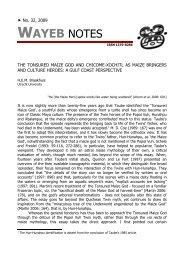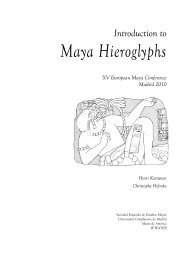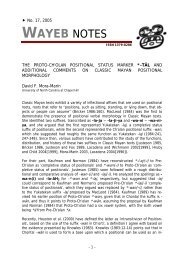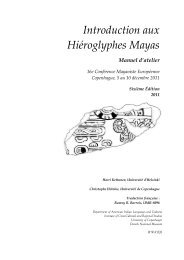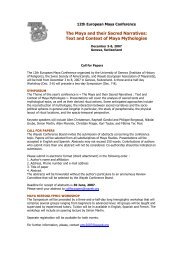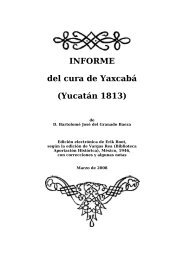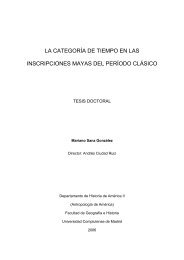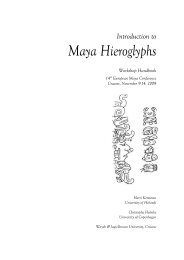Introduction to Maya Hieroglyphs - Wayeb
Introduction to Maya Hieroglyphs - Wayeb
Introduction to Maya Hieroglyphs - Wayeb
You also want an ePaper? Increase the reach of your titles
YUMPU automatically turns print PDFs into web optimized ePapers that Google loves.
Kettunen & Helmke 2011<br />
Concise Glyph Dictionary<br />
CONCISE CLASSIC MAYA – ENGLISH DICTIONARY<br />
hieroglyph 72 : transliteration 73 : transcription 74 : translation 75 : alternative spellings 76 :<br />
a/AJ<br />
a<br />
aj<br />
(1) phonetic sign<br />
(2) neutral or male prefix 77<br />
ACH?<br />
AT?<br />
ach<br />
at / aat<br />
(1) penis ACH?-cha,<br />
AT?-ti,<br />
AT?-ta<br />
AHIN? / AYIN? ahiin / ayiin (1) caiman (n)<br />
(2) lizard (n)<br />
a-AYIN/AHIN-na,<br />
AYIN/AHIN-na,<br />
AYIN/AHIN-ni<br />
AJAW 78<br />
ajaw<br />
ajaaw?<br />
(1) lord (n)<br />
(2) king (n)<br />
AJAW-wa,<br />
a-AJAW,<br />
a-AJAW-wa,<br />
a-ja-wa<br />
AJAW<br />
ajaw<br />
ajaaw?<br />
(1) lord (n)<br />
(2) king (n)<br />
AJAW-wa,<br />
a-AJAW,<br />
a-AJAW-wa,<br />
a-ja-wa<br />
AJAW<br />
ajaw<br />
ajaaw?<br />
(1) lord (n)<br />
(2) king (n)<br />
AJAW-wa,<br />
a-AJAW,<br />
a-AJAW-wa,<br />
a-ja-wa<br />
72<br />
A given sign represented in this column is only one possible version of different spellings <strong>to</strong> be found in the <strong>Maya</strong> hieroglyphic corpus. For<br />
example the word for “lord” or ajaw can be rendered in the following ways: AJAW, a-AJAW, AJAW-wa, a-AJAW-wa, and a-ja-wa. Use of<br />
different graphic forms, furthermore yields dozens of possible combinations, each representing distinct collocations (see alternative spellings in<br />
the rightmost column and see also chapter 7. Logograms]). The arrangement of this dictionary is based on alphabetical order of transcriptions.<br />
When a particular hieroglyph is usually or always preceded with a possessive pronoun u-/y-, it is placed in parentheses: e.g. (y-)uk’ib . The<br />
alphabetical order thus follows the stem of the word rather than the most common (inflected or derived) appearance in the corpus.<br />
73<br />
This is a broad transliteration that excludes analyzed/interpreted sounds (vowel length, glottal s<strong>to</strong>ps, and /h/’s [preconsonantal velar fricatives])<br />
that are not inbuilt/inherent parts of hieroglyphs but were, conversely, indicated by orthography rules, grammatical inflection, and in the case of<br />
underspellings, provided by the native reader [see page 63 onwards]).<br />
74<br />
This is a narrow transcription including reconstructed sounds (marked by [square brackets]) based either on his<strong>to</strong>rical, internal, or paleographic<br />
evidence.<br />
75<br />
This is really a gloss rather than translation (a gloss is a short general translation of a word or morpheme which does not take in<strong>to</strong> account the<br />
context in which it occurs). Nonetheless, when several well-attested meanings exist, these are sorted (in the order of numerical ascendancy) from<br />
the most literal <strong>to</strong> the most figurative. The latter do (<strong>to</strong> a certain degree) take in<strong>to</strong> consideration the various meaning that the contexts of<br />
wordscan potentially imbue them with. Abbreviations of grammatical category follow the expression in (parentheses): adj: adjective, adv: adverb,<br />
cn: composite noun, cop: copula, dem: demonstrative pronoun, ip: independent pronoun, iv: intransitive verb, ivd: intransitive verb (derived), n:<br />
noun, ncl: numeral classifier, num: numeral, part: particle, poss: possessive prefix, prep: preposition, prpo: pronominal (absolutive) postfix, prpr:<br />
pronominal (ergative) prefix, pv: positional verb, sp: stative participles, <strong>to</strong>p: <strong>to</strong>ponym, tv: transitive verb, tvd: transitive verb (derived).<br />
76<br />
The alternative spellings are based on Boot 2009, Lacadena and Wichmann 2004, Lacadena and Zender 2001, and Lacadena (personal<br />
communication, 2003).<br />
77<br />
A prefix, proclitic, or classifica<strong>to</strong>r denoting person, agent, doer, office, causer, characteristics, or male sex.<br />
78<br />
See page 15 for different variations of the ajaw sign.<br />
79/154



